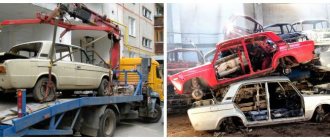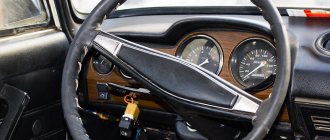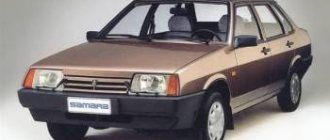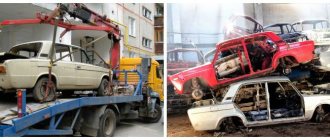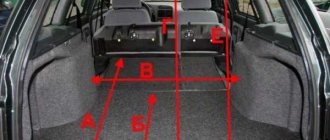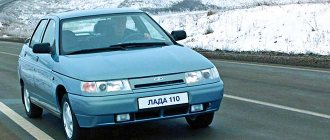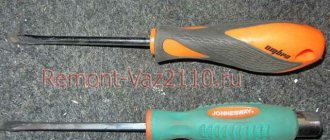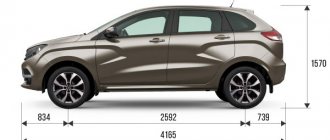Bodies and what they are like
As you know, the body on the “ten” is load-bearing and repeats the basic design of any modern passenger car. Today it is customary to talk about several types of bodywork. The frame and supporting body are considered the main ones.
The difference between frame and load-bearing
How much does the body of a VAZ 2110 weigh?
All the main components of the car are located on the frame; it serves as a support and is itself fixed to the wheels of the car by means of suspensions. If you pay attention to trucks, then the frame can be seen with the naked eye, and thus you can draw appropriate conclusions about its structure. In “passenger cars” there is no frame, or it would be more accurate to say that on some passenger cars the frame-body assortment forms a single whole, called the body.
Frameless bodies, which include the metal frame of the VAZ 2110, are made in such a way as to withstand the mass of numerous heavy components. For this purpose, the body floor is well reinforced, and most of the overall parts are made of materials with a lightweight base.
On frameless bodies, the role of the frame is performed by the spars. They can be said to be responsible for the massiveness of the entire body structure. From time to time, these components are subjected to unplanned and shock loads that change very quickly in different directions. This operating scenario cannot have a positive effect, and over time, the welding points break, the bolts become loose, and the solidity of the entire body structure weakens.
VAZ 2110 body diagram
The car body also feels the load from a running engine. It vibrates strongly, although the engine itself and the cylinders are designed to absorb some of the vibrations. To minimize the effects of vibrations on the body, manufacturers use special cushions or dampers, as well as washers made of dense rubber.
Note. The effect of these pads can be clearly determined by monitoring the operating unit with the hood open. The engine “growls” and shakes, but the body doesn’t care.
The most important task of a frameless car body is to transport luggage and passengers. At the same time, the machine must also provide major protection. The number of people transported and the weight of the permissible load are determined by the designers responsible for the layout and other parameters of the body.
If you imagine the frame of a “car” in the form of its components, then its main parts are three main zones, implying the trunk, the passenger compartment and the front. The finished look of the solidity of the frame is given by its hinged parts or “plumage”, which includes various panels.
Body types of the “tenth” family
VAZ 2110 body diagram
The difference in body types, again, is associated with what one or another model is intended for. The car may be intended for off-road travel, and then it will be designed as a crossover or a full-fledged all-terrain vehicle, or it may be intended only for city driving.
Note. The body of the VAZ 2110 is a typical sedan. Models associated with the “ten” already have other body types: 2111 – station wagon, 2112 – 5-door hatchback, 21123 – coupe or 3-door hatchback.
It will be useful to know that over the entire production period of the 2110 model, VAZ creates many variations of this sedan. In particular, the Consul limousine, with an even longer wheelbase, deserves attention.
The design of the sedan began immediately after the VAZ 2108 became obsolete, when the plant decided to replace the project. But the release of the “ten” was not yet imminent. The fact is that the designers made many revolutionary improvements that significantly increased the cost of the project. Due to the economic crisis that reigned in the country at that time, the project was moved forward several years, and only in 1995 mass production of the “ten” began.
VAZ 2110 body diagram of station wagon 2111
The sedan is the classic and most popular body style of modern cars. The interior includes 2 rows of seats and usually accommodates 4-5 people including the driver. The luggage compartment in sedans is properly separated from the interior.
For many, to this day, the question of the merits of the VAZ 2110 car is somewhat controversial. It is clear that it cannot compare with foreign cars, but the presence of “ten” running on the roads of our country speaks volumes.
Dimensions and how much it weighs
The body length of the “ten” sedan is 4265 mm, which is only slightly less than the “universal” dimensions. This length looks the most organic not only among the models of the “tenth” family, but also in VAZ as a whole.
Instructions for VAZ 2110 body dimensions and repairs
We also note that the length of the “ten” is 6 cm longer than the length of the only “Samarov” sedan - VAZ 21099. The same goes for other parameters:
- The longitudinal distance between the wheel axles is 3.2 s longer;
- Body height is 1.8 cm higher;
- Ground clearance is 5 cm higher.
But both gauges are the same for “99” and “tens”. In addition, both models have similar gearboxes and engines. But still, in general, the technical characteristics of the “tens” and “99” are different. The “Ten” is able to achieve better speed and demonstrate enviable maneuverability on the road compared to the “99”, precisely due to the body design, made with modernizations and significant improvements. In particular, these are smooth body lines and completely modernized control systems.
Due to the greater length, which experts called “ideally sufficient,” the trunk of the VAZ 2110 sedan becomes very spacious. Its usual layout is 415 liters, which is already the envy of competitors.
Dimensions 2110
The large volume of the luggage compartment allows you to transport by car not only the essentials, including a spare wheel and tools, but also many additional things. If you remove the rear seats, turning the rear of the cabin into an additional trunk, you can transport up to 1270 liters of cargo.
The wheelbase of the “ten” is 2492 mm, which is also very good. If we add to this the length of the trunk - 944 mm, then on a long journey, if you have a sleeping mattress, you can make a quite comfortable bed.
VAZ's new sedan is wider, taller and longer, but also heavier than the standard family of cars (1020 kg). This was to be expected, because the designers sought to increase the interior space, thereby increasing the comfort of people sitting in the cabin.
Results
Although the VAZ-2112 car has not been produced for a long time, it can be seen quite often on the streets of many cities in the post-Soviet space. The car was able to prove itself well, especially at the beginning of production. Many even mistook this hatchback for a foreign car. Even today, the car does not have such a rough design as, for example, the “nine” or similar cars, and even looks modern.
If the driver does not leave his car unattended, it will look good. “Dvenashka” received an average ground clearance, front-wheel drive, a more or less good interior and a spacious trunk
It is clear that the model cannot compete with foreign cars, but for its price it is the best option.
It is especially suitable for tuning lovers, as it has a lot of opportunities for improving the appearance, interior and technical parts. It will not be possible to avoid a poor-quality interior and low level of noise insulation. Also inside, especially in the back row, there is not enough free space. Creaking sounds will constantly accompany the driver on the road.
The power of the power plants is not always enough; the lack of power is mainly felt when overtaking. But the engine can be called quite economical, even in urban areas. The VAZ 2112, although not an ideal car, is good for a first car, as it has a low cost on the secondary market, low price tags for spare parts and is easy to repair.
How much does the VAZ weigh?
Perhaps one of the most popular cars in the post-Soviet space was, is and remains the VAZ. This car has captivated many generations. However, how did it all begin? When was the first VAZ car produced and how much did it weigh? You will learn the answers to these and other questions from this article.
The first VAZ car was produced by the Volzhsky Automobile Plant on April 19, 1970. The make of this car was VAZ-2101 Zhiguli. Its production was carried out according to the analogue of the Fiat concern. Moreover, VAZ owes its appearance to this particular brand of Fiat 124, produced in 1966. Here, in fact, is it:
As a result of some design improvements, the first domestic car, the VAZ 2101 of 1970, was produced:
The weight of this car was 955 kg. Moreover, of this mass the engine weighed 114 kg.
It has not lost its popularity to this day. In 2000, it was recognized as the best car among eighty thousand car enthusiasts surveyed in the CIS countries and Russia. It was named the best car of the century, VAZ 2101. At the time of its production, it was considered the most comfortable, reliable and modern domestic car. Its presence was a sign of wealth and prosperity!
But the Volzhsky Automobile Plant did not stop there. He created entire collections of this car. Each of them differed in its configuration, as well as its total weight. Therefore, now we will compare some VAZ models by their weight.
- VAZ 2102 has a weight of 1010 kg .
- VAZ 2103 has a weight of 965 kg .
- VAZ 2104 has a weight of 1020 kg .
- VAZ 2105 has a weight of 1060 kg .
- VAZ 2106 has a weight of 1045 kg .
- VAZ 2107 weighs 1049 kg .
- VAZ 2108 weighs 945 kg .
- VAZ 2109 weighs 915 kg .
- VAZ 2110 has a weight of 1020 kg .
- VAZ 2111 has a weight of 1055 kg .
- VAZ 2112 has a weight of 1060 kg .
- VAZ 2113 weighs 975 kg .
- VAZ 2114 weighs 985 kg .
- VAZ 2115 has a weight of 1000 kg .
- VAZ 2116 weighs 1276 kg .
- VAZ 2117 has a weight of 1110 kg .
- VAZ 2118 has a weight of 1110 kg .
- VAZ 2119 has a weight of 1110 kg .
- VAZ 2120 has a weight of 1110 kg .
- VAZ 2121 has a weight of 1550 kg .
- VAZ 2122 has a weight of 1122 kg .
- VAZ 2123 has a weight of 1300 kg .
But this is the total weight of a VAZ car. As for some parts of the car, the weight of, for example, a VAZ 2106 can be decomposed as follows:
- The weight of the engine with equipment is 140 kilograms .
- The weight of the gearbox is 26 kilograms .
- The weight of the square shaft is 10 kilograms .
- The weight of the rear axle is 52 kilograms .
- Radiator weight – 7 kilograms .
- Body weight – 280 kilograms .
On average, the weight of all components of a VAZ car has approximately the same mass. Throughout the entire period of existence of this car, quite interesting facts have been recorded that simply cannot be ignored. It’s hard to imagine that a car weighing an average of 1 ton is very popular.
So, the VAZ 2121 Niva car is not only the most popular throughout the USSR, but also the most exported. Just imagine, this model was produced in 1.8 million cars. And of this amount, 500,000 were sold to more than 100 countries. As we remember, the weight of the VAZ 2121 is 1550 kilograms . This means that over the entire period, 775,000,000 kilograms of this car were sold! Also, this particular model of all Soviet cars was driven in Japan. As for the design of the VAZ 2108, it was developed by the currently well-known company Porshe. Its engine weighs 127.3 kilograms . This became necessary due to the fact that the demand for this brand of car was greatly reduced. For this reason, they decided to modernize it.
Moreover, the VAZ car became more popular because the Lada car was the first car of the famous Formula 1 racer - Kimi Raikkonen. His father loved this car extremely much for its reliability.
So, we learned that each VAZ car model has its own separate weight. But throughout the history of its existence and production, it has not undergone major changes.
Source
Interior
If a person who drove a “tenth” model sits in a “two”, he will instantly find a fairly important difference. The gearbox housing is made of plastic and in the VAZ-2112 it is slightly larger
Because of this, from the right side of the edge of the brake pedal to the transmission tunnel-gearbox housing is approximately 9 centimeters. It turns out that within these 9 centimeters there should still be a gas pedal.
It is clear that pressing such pedals is not so convenient, because together with the accelerator pedal you can press the brake in the reverse order. The steering wheel is exactly the same as in regular “tenth” models. The cars received an adjustable steering wheel. As for the seats and door panels of the twelfth model, they were covered with fabric in the same color as the vehicle body itself.
Due to the wing mounted on the luggage compartment lid, the level of visibility drops significantly. Some car owners decide to dismantle it, also justifying it by the fact that this improves the appearance of the Lada 2112. The glove compartment, located in the “two-piece” in front of the front passenger, turned out to be quite spacious and can accommodate A4 sheets.
Speaking of the front panel, it reminds some of the familiar lowest torpedo from the early releases of the G8. Engineers were able to create a convenient instrument cluster. Of course, there are some inconveniently located control buttons, but the torpedo itself as a whole is not as bad as it might seem.
It’s worth being frank: the twelfth model has hard plastic that often produces creaking sounds, but it is clear that it is much more ergonomic than the “eighth” family. In the center you can see the famous signaling device with a drawing of a car, informing the driver that not all doors are closed. On the side there is a clock, an emergency signal button, which could have been made a little larger, as well as adjustments for the stove and damper.
In general, sitting at the helm of the Lada-2112 is quite free. However, the steering wheel covers the buttons for lights, fog lights and heated glass. The switches are conveniently located under the steering wheel, so there is no need to reach them. The steering wheel is precisely adjusted in thickness, so it is convenient to use. I would especially like to thank the engineering staff for installing height-adjustable seat belts.
There is enough free space at the feet of the person sitting in front. The factory decided not to spoil the door trim in any way, so it evokes more pleasant emotions than, for example, the hard plastic of the Lada Priora. The presence of a pleasant, fleecy upholstery material and a convenient pocket at the bottom will only please the driver. The rear end can no longer please so much. A passenger sitting on the back sofa of a VAZ 2112 will slightly touch the front seat, but the sofa itself is quite comfortable.
It is two-part (the back is divided into 2 parts). It was “transferred” to the twelfth model from 2111. This made it easier to transport luggage. The average person doesn't hit the ceiling with their head. Inspecting the ceiling upholstery, you can notice a rather interesting element. The black plastic box has a sensor that sets the optimal temperature inside the car.
It cannot be said that the luggage compartment of the VAZ 2112 is very large, but it is not small either, as for this class. For the driver, 399 liters are provided. But if necessary, this figure can be increased by folding the back of the “gallery” in parts in a ratio of 2:1, which already provides a volume of up to 730 liters of usable space.
The hatchback's underground raised floor has a standard set - a full-fledged spare wheel and the necessary tools. You can also notice a small shelf for light items on top. Speakers were placed near the rear windows. Another difference from the 8th family of cars is the low loading height, which makes loading/unloading luggage much easier.
External description of the VAZ-2112
This brand of car differs from its previous brothers in both external and internal parameters. The body of the car has been improved, it has become slightly longer, due to this the volume of the luggage compartment has increased to 400 liters. And if you fold down the rear seats, you can carry more cargo.
It is especially worth noting the convenience of splitting the rear seat, which allows you to transport small loads while maintaining the comfort of the car. Add to this a more sporty handling. The brand has retained the advantages of its predecessors with minor innovations depending on the configuration.
Thus, the most budget option was considered to be the 21122 package, where the engine from 2111 was installed, with non-ventilated brakes from 2108 and without electric windows.
The elite version was 21128 with an engine capacity of 1.8 and a power of 100 horses. The production of the popular brand VAZ-2112 lasted from 1999 to 2008 in small batches, this made it possible to maintain stable demand for this car.
Geometric dimensions of openings
| For body 2111 | For body 2112 | For body 21123 |
| A – long diagonal of the rear side window frame – 780 mm | D - long diagonal of the rear side window frame - 710 mm | And – short diagonal of the front doorway – 1000 mm |
| B - short diagonal of the rear side window frame - 370 mm | E - short diagonal of the rear side window frame - 230 mm | K – long diagonal of the front doorway – 1500 mm |
| B – diagonal of the rear door opening – 1280 mm | F - diagonal of the rear door opening - 1320 mm | M - short diagonal of the rear side window frame - 720 mm |
| D – distance from the middle of the upper beam of the rear door opening to the middle of the lower beam of the opening – 925 mm | Z - distance from the middle of the upper beam of the rear door opening to the middle of the lower beam of the opening - 1050 mm | H - long diagonal of the rear side window frame - 1040 mm |
Body parts for VAZ 2112
Weight of VAZ 2110 bodies
The VAZ 2110 2110 1.5 MT sedan is equipped with one of the lightest bodies, its weight is 1010 kg.
Model body weight:
Body weight of modifications of the VAZ 2110 sedan (1995 – 2009):
- 1010 kg, 1020 kg, 1100 kg, 1330 kg.
Model body information:
The body of the VAZ 2110 is load-bearing and has a closed power structure, that is, it forms a closed contour (due to the presence of a roof) and brings together all vertical power elements.
All parts of the VAZ 2110 body are made by stamping from low-carbon, thin-sheet steel (thickness from 0.7 mm to 0.9 mm), heavily loaded parts are made from sheet 1.2 mm thick.
Important: according to the technical documentation, one of the heaviest bodies is the VAZ 2110 21109 Consul 1.5 MT sedan, its weight is 1330 kg.
Other names:
Until 2014, the VAZ 2110 model was assembled under license from AvtoVAZ vehicle kits at the Bogdan Corporation automobile plant under the Bogdan-2110 brand.
Subtleties of the model range:
The model is equipped with an electronic engine control system, a diagnostic unit (on-board computer), power steering, electric windows, and a new body painting technology is used.
Years of production Years of production: 1995-2007.
Door fastening
Each door at the front end is suspended from the body on two hinges. The cheek 1 of each hinge, adjacent to the body pillar b, is secured with screws 4 screwed into a plate 5 held inside the pillar by a holder 3. The dimensions of the holder allow the plate to be moved during adjustment. The hinge cheek 10, adjacent to the door, is attached to it with bolts 8, which pass through the holes in the door reinforcement V and are screwed into the threaded holes of this cheek.
To prevent dust from penetrating inside the front and rear doors, the cheek piece 10 of the hinge passes through a sponge seal 11, which is held by a holder 12 welded to the door. To protect the body from dust in the places where the front door hinges are attached, the cheek piece 1 of the hinge passes through a sponge seal 2 glued to the body pillar. and the mounting holes in the rack are closed with a rubber plug 7. The cheeks of the hinges are steel; They are made from a special rolled profile that is cut. The cheeks are connected with a finger. The finger is lubricated through the hole in the head of the cheek. The described fastening allows you to adjust the doors, that is, move them in any direction: up, down, forward, backward, inward and outward. This adjustment ensures the correct position of the door, determined by a uniform gap around the perimeter of the door and the absence of steps between the surface of the door and the areas of the body adjacent to it.
Rice. Door stop (horizontal section): I - door in open position; II - door in closed position; 1 - limiter; 2 — roller shank; 3 — limiter jumper; 4 — plate holder; 5 - plate; 6 — bracket; 7 - screw; 8 — door amplifier
Car weight VAZ-2112
The VAZ automobile concern regularly delighted car enthusiasts with new models, starting in the 60s of the last century. Each new car featured unique additions and improvements. Even the weight of the car increased from brand to brand due to additional modifications.
The total weight of the VAZ-2112 is 1060 kg. On average, the weight of the main components does not differ much between models. So:
- engine weight of model 2112 with a volume of 1.5 liters - 126 kg;
- gearbox weight – 27 kg;
- the radiator weighs 8 kg;
- the weight of the bare body of the VAZ-2112 is 290 kg.
The engine is considered an important, unchanged part of a VAZ car; of course, over time it has undergone new modifications, but the basic basis has always been model 21083. While maintaining the basic parameters, the developers increased the power and service life of the engine in subsequent models.
The engine began to save fuel significantly, but there remained a lack of torque at low speeds. The rollers and belt drive are also unreliable, and if the timing belt breaks, there is a high probability of bending the valves.
Other parameters of Lada Priora:
| Bare body weight max (kg) Maximum vehicle weight for different modifications Data are presented in kilograms (kg) | Modifications Number of model modifications in our database Body weight of Lada Priora |
| Parameter Vehicle Parameter |
| Total weight of the Lada Priora car | |||
| General view General view of the car | Curb weight min (kg) Minimum vehicle weight for different modifications of Lada Priora | ||
Data are presented in kilograms (kg)
Caution: the above data are official figures from manufacturers, however, please note that the information is for reference only and does not guarantee absolute accuracy.
Source
Features of car recycling
Before you scrap your car, you should familiarize yourself with the principles of this procedure. The average weight of a vehicle is 1000 kg. If the entire car can be recycled, the collection point will deduct 30% for clogging. The latter includes all non-metallic elements, pollution, etc.
Let's consider how much a car for scrap metal weighs using the example of a VAZ 2105. The weight of the latter is 955 kg. Thus, taking away the blockage, we get about 660 kg. You should also take into account the price of scrap, which differs depending on the city. As a rule, in megacities, the number of rubles received for a car will significantly exceed the amount earned in a similar organization in a small locality.
Before calculating the profit from a scrapped car, you need to take into account transportation costs. If the car is a pile of metal, you need to take care of a tow truck. If there are spinning wheels and functional steering, the car can be transported in tow. Then, this expense item will not be so significant. Therefore, in order to calculate how much a Zhiguli costs when scrapped, it is not enough to know how much a VAZ 2109 or 21099 weighs for scrap metal (915 kg). It is necessary to take into account the features of recycling and the requirements of collection points. It would be useful to know the average cost of scrap metal in the region. Additional awareness will allow you to avoid fraud on the part of unscrupulous receivers.
Despite the fact that disassembling a car is a labor-intensive procedure, many owners still decide to take this step. Thus, you can sort ferrous and non-ferrous metals and hand them over separately, removing the good parts. From an economic point of view, the procedure will be justified.
Let's consider how much a VAZ 2106 weighs for scrap metal based on individual significant structural elements:
It should be noted that dismantling machine parts requires a lot of time and certain skills. In the absence of the latter, it would be more rational to recycle it entirely.
Source
Recommendations
Comments 16
I also sold it without a roof for 2k, with the price of metal being 6.5r/kg
everywhere? Some of us also have 5. There are also 7, but there the scales are twisted too much))
yes, if you take the current to the city
If the body is alive, they can buy a quarter or anyone who needs anything (left glass, roof, rear part), and this is more expensive than scrap metal
It’s a long time and he’s bothering me...
they seem to cost more in pieces)
Firstly, they won’t accept a whole body for scrap metal, they even take it in pieces with reluctance. And secondly, where metal is accepted, there should be scales that weigh the truck with metal on board at the entrance and without metal at the exit, and they pay the difference, and who even needed your weighing?
They are unlikely to accept it whole; they will have to cut it anyway. So you can do this and weigh it on a relatively small scale. I disassemble cars myself, I give advice) It is necessary to at least dismember them into 4 parts. two large circles for a grinder should be enough
Thank you, but here at our house they accept small Soviet scales, I’m from the region 100 km from Ryazan
Comments 16
I also sold it without a roof for 2k, with the price of metal being 6.5r/kg
everywhere? Some of us also have 5. There are also 7, but there the scales are twisted too much))
Tens body care and repairs
Do-it-yourself VAZ 2110 body repair
The overall body of the “ten” looks more reliable, durable and resistant to corrosion. All-metal and partially galvanized, it comes off the assembly line already treated with anticorrosive, ready for harsh operating conditions.
On the other hand, we must pay tribute to our car owners, who are accustomed to finishing everything with their own hands. In particular, while remaining adherents of the domestic automobile industry, they turn a blind eye to the differences and shortcomings of technology in comparative terms and take additional care of the body so that it serves for many years without problems. Russian car owners almost always add special protection to the standard anti-corrosion treatment.
VAZ 2110 body repair and polishing
Preventative work specifically involves tinting the bottom of the car, treating sills and fender liners with Movil.
Note. We can say with confidence that among the “dozens” with high mileage, even today you can find examples that have been so well cared for by the owner that they look like new.
People's love for the “ten” is also symbolized by the succinct names given to the car by amateurs. “Matryoshka”, “pregnant antelope”, “chubby” - all these nicknames, albeit with some degree of irony, speak of love for the car. If at first the unique, new design of the VAZ model raised questions, then over time the angular shapes of the “bow” and “stern” became familiar.
Here are the preventive works that are usually carried out on the body of the “tens” throughout the entire operational period:
- Caring for paintwork;
- Lubrication of metal components of the body;
- Cleaning of technical holes;
- Periodic anti-corrosion protection of the body as a whole and treatment of hidden areas;
- Noise insulation;
- Sealing.
VAZ 2110 body repair
To protect the original paintwork of the body, you must be able to select the appropriate polishes and follow the rules for their application. In addition, the VAZ 2110 must first be washed when the car is new, only with cold water, and for treating paintwork, use polishes that do not contain abrasives.
Caring for the paintwork of a car with a 3-5 year mileage implies a different scenario:
- Use products for weathered surfaces (they contain a certain amount of abrasive).
Accordingly, for a body older than 5 years:
- Use products specifically designed for aged surfaces.
It is also recommended to polish the body in small areas by hand using clean flannel. This is done to prevent the polish from drying out during application.
Polishes PMA-1 and PMA-2 have proven themselves well.
Body polish
More good tips on the body in general:
- Do not store the car under rubber covers;
- Do not place rubber objects on painted surfaces (they will leave stains that are almost impossible to remove);
- Protect the paintwork from contact with alkalis, brake fluid and other chemicals that can destroy the coating.
It is recommended to lubricate rubbing parts and body elements from time to time in order to increase the durability of the metal frame. So, this should be done at least every 15 thousand km of the car or once a year.
Here's how and where to do it:
- Apply engine oil to door hinges;
- Apply CV joint grease-4 or Molikot to the limiters;
- Lubricate door locks with FIOL-1;
- Apply VTV-1 aerosol lubricant to the lock cylinders;
- Use the same product to lubricate the hinges and springs of the fuel tank hatch;
- Lubricate the hood lock with FIOL-1;
- Use the same tool to lock the trunk lid.
Anticorrosive treatment also needs to be given great attention. Hollow parts of the body and parts located in the lower part are most susceptible to the negative effects of rye (they are constantly exposed to moisture and dirt due to their close location to the road surface).
It has proven itself well for protecting the metal components of the body from corrosion. As for the treatment period, it is recommended to carry it out every year.
Due to the complexity of the work, it is recommended to treat hidden body cavities with anticorrosive agents at a service station. If the garage has the appropriate tools and equipment, then the process is as follows:
- The car is placed on a jack;
- The casing and all components that interfere with access to hidden cavities are removed;
- The holes are washed until clean water flows out;
- The surfaces are thoroughly dried, and all areas where the anticorrosive is applied are blown with compressed air.
The table below shows hidden cavities and how to apply anticorrosive.
Tuning
VAZ-2112 is one of the best solutions of the Russian automobile industry. The car has little comfort. However, many people strive to highlight their vehicle through tuning. Nowadays, tuning has become very popular, especially for domestic cars. Due to the fact that manufacturers have reduced the body size, the hatchback has become more comfortable to drive.
Another advantage can be added to the high ability to maneuver during turns, which makes this car look like a sports class car. “Dvenashka” is, on the whole, a complete and comfortable car, but almost every master will find something that needs to be improved. For example, you can update the silhouette of a car. For this, various additions are used that allow you to create a new appearance for the Lada 2112. In addition, experts advise increasing the aerodynamic data of the vehicle.
Appearance tuning
To change the appearance, new body components should be used. Some VAZ-2112 owners resort to a stylish aerodynamic body kit, which can have a different appearance. There is a sporty type, and there is a body kit that emphasizes the unique style and characteristic feature of the Soviet hatchback.
After installing such body kits, the “two-piece” will be a little similar to American cars. There are two types of aerodynamic body kit for such a five-door:
- The first - with a sporty bias - affects the smoothness of control when moving at high speed due to the correct structure;
- The second is one that improves style. The kit includes an impressive air intake, which allows you to easily cool the power unit and braking system.
You can upgrade your car if you work on its lighting. The lighting is installed not only under the bottom itself, but also the lights located at the stern. More modern front optics will help rejuvenate the hatchback, giving it a sporty touch. In this case, LED lighting is used.
On the practical side, you can install a heated windshield, which helps save a lot of time when cleaning the glass in winter. In the warm season, such tuning of the VAZ-2112 helps reduce fogging of the vehicle.
Interior tuning
The interior of the car is the favorite part of the car for tuning enthusiasts. Typically, owners decide to install lighting in the interior. Not everyone likes the standard dashboard lighting. Such work can be carried out by any car owner of a Lada 2112 hatchback. There are craftsmen who replace the ceiling with one similar to that of a Lada Priora.
It fits perfectly as it matches the dimensions. Similar actions are carried out with door trim. To improve the level of comfort, noise insulation work is being carried out. Also, for convenience, new seats with good lateral support, a high-quality music system, etc. are installed.
Tuning the technical part
To modernize the technical characteristics of the twelfth model, it is important to increase the displacement. It is determined based on the stroke diameter and piston
To increase this volume, use a factory version or do-it-yourself improvement. If you choose the second case, you will have to convert the factory stroke, but in this way it will not be possible to significantly increase the volume.
Engine chip tuning is very popular today. There is an economical and original sports version of chip tuning for the VAZ 2112. The sports method includes increasing the dynamic performance of the car in the city. You will have to be prepared for increased fuel consumption.
If your large fuel appetite is a bit daunting, you can switch to gas equipment. The economy option reduces fuel consumption in the city, which is what many people are interested in.
Modifications
| Name | Year of issue | |
| LADA 110 (2110) 1.5 | 01.1995 – 12.2005 | Characteristics |
| LADA 110 (2110) 1.5 | 01.1995 – 12.2005 | Characteristics |
| LADA 110 (2110) 1.5 16V | 01.1995 – 12.2005 | Characteristics |
| LADA 110 (2110) 2.0 i | 08.1996 – 07.2000 | Characteristics |
| LADA 110 (2110) Wankel | 06.1997 – 09.2004 | Characteristics |
| LADA 110 (2110) 1.5 | 10.2000 – 12.2005 | Characteristics |
| LADA 110 (2110) 1.5 16V | 10.2000 – 12.2010 | Characteristics |
| LADA 110 (2110) 1.6 | 01.2000 – 12.2012 | Characteristics |
| LADA 110 (2110) 1.6 | 01.2000 – 04.2007 | Characteristics |
Steering
To move normally in a car, the driver needs to make turns, U-turns or detours, that is, deviate from straight-line movement, or simply control his car so that it does not drift to the side. For this purpose, its design provides steering control. This is one of the simplest mechanisms in a car. Let's look at the names of some of the elements below. The steering system consists of:
These devices consist of a steering system that is connected to the front wheels by steering and brakes.
Technical characteristics of VAZ 2110
| Automobile | Lada 2110 | ||||
| Modification name | VAZ-2110 | VAZ-21102 | VAZ-21103 | VAZ-21101 | VAZ-21104 |
| Body type | sedan | ||||
| Number of places | 5 | ||||
| Length, mm | 4265 | ||||
| Width, mm | 1680 | ||||
| Height, mm | 1420 | ||||
| Wheelbase, mm | 2492 | ||||
| Curb weight, kg | 1010 | 1020 | 1050 | 1020 | 1040 |
| engine's type | petrol | petrol, fuel injection | petrol, fuel injection | petrol, fuel injection | petrol, fuel injection |
| Location | front, longitudinal | front, longitudinal | front, longitudinal | front, longitudinal | front, longitudinal |
| Number and arrangement of cylinders | 4, in a row | 4, in a row | 4, in a row | 4, in a row | 4, in a row |
| Working volume, cubic meters cm. | 1499 | 1499 | 1499 | 1596 | 1596 |
| Number of valves | 8 | 8 | 16 | 8 | 16 |
| Maximum power, l. With. / rpm | 73 / 5600 | 78 / 5400 | 93 / 5600 | 81 / 5200 | 89 / 5000 |
| Maximum torque, Nm / rpm | 109 / 3400 | 116 / 3000 | 128 / 3700 | 120 / 2700 | 131 / 3700 |
| Transmission | manual, 5-speed | ||||
| Drive unit | front | ||||
| Tires | 175/70 R13 | 175/65 R14 | 175/70 R13 | 175/65 R14 | |
| Maximum speed, km/h | 165 | 170 | 185 | 170 | 180 |
| Acceleration time 0-100 km/h, s | 14 | 14 | 12,5 | 13,5 | 12 |
| Fuel consumption in the combined cycle, l/100 km | 7,6 | 7,2 | 7,2 | 7,5 | 7,2 |
| Fuel tank capacity, l | 43 | ||||
| Fuel type | petrol |
Priora station wagon, quite an objective article!
I found a good article on the Ukrainian website about Priora, people write objectively! Apparently the sponsors of “Behind the Wheel” haven’t gotten to them yet
